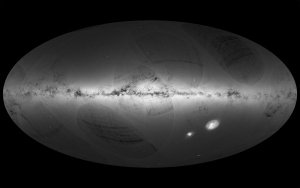I consider myself to be a lover of science, even before I took this class, which is why I knew I needed to sign up for this course once I first found out about it. I remember in one of the lectures in our first week, Andrew was discussing ‘science’s most amazing discovery: the fact that we exist. There was a few things about this lecture that I liked, and it really got me excited for this semester to have Andrew as a professor for a class like this, and not some cranky old know-it-all professor. As Andrew was progressing through this existence lecture he came to a point that I found to be fascinating and profound: you exist in a tiny part of a huge hostile universe. This is something that I was already aware of from past experiences with astronomy classes and learning from curiosity.
Fast forward to this week, when I am looking on Google News page for some good news stories and come across this headline about the first map of the Milky Way Galaxy. Initially I was skeptical about how this could actually be possible and whether or not this map was based on physical observations, or just a hypothetical creation based on mathematical theories and formulas. It turns out that there actually is a satellite, positioned in a gravitationally locked orbit directly opposite of the earth’s location in its orbit around the sun. This was shocking to me that I had never heard about this satellite before, but it apparently had launched in 2013 by the European Space Agency and it is called the Gaia Satellite.
Gaia’s mission is to attempt to map the massive structure that is the Milky Way Galaxy which is approximately 100,000 light years across. Although there are believed to be over 300 billion stars in the milky way galaxy alone, the Gaia team obviously doesn’t expect to map and measure every single star individually, much less the myriad of planets, moons, and asteroids that undoubtedly occupy the interstellar space in the vastness of our galaxy. The team more realistically expects that an observation of at least 1 billion stars will give them enough data and information to learn more about our galaxy like its structure, formation, and history. As of now, the satellite has actually surpassed expectations, and has measured approximately 1.142 billion stars and is still going! This is the first image Gaia has sent back and is expected to be the first of many more to come:

